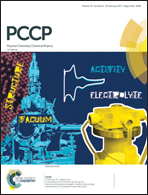Nonadiabatic Renner–Teller quantum dynamics of OH(X2Π) + H+ reactive collisions
Abstract
Following previous studies on the O(3P) + H2+(X2Σg+) collisions, we present the nonadiabatic quantum dynamics of the reactions OH(X2Π) + H′+ → OH′(X2Π) + H+, exchange (e), → OH+(X3Σ−) + H′(2S), quenching (q), and → OH′+ (X3Σ−) + H(2S), exchange-quenching (eq). The reactants and products correlate via the ground ![[X with combining tilde]](https://www.rsc.org/images/entities/char_0058_0303.gif) 2A′′ and first excited Ã2A′ electronic states of OH2+, which are the degenerate components of linear 2Π species. Therefore, they are strongly perturbed by nonadiabatic Renner—Teller (RT) effects, opening the (q) and (eq) channels that are closed in the Born–Oppenheimer approximation. Using accurate potential energy surfaces (PESs) and RT matrix elements, initial-state-resolved reaction probabilities, real-time dynamics, cross sections, and rate constants of the product channels are obtained through the time-dependent real wavepacket (WP) method and full coupled-channel calculations. Owing to the nonadiabatic couplings, the WP jumps from the excited Ã2A′ surface to the
2A′′ and first excited Ã2A′ electronic states of OH2+, which are the degenerate components of linear 2Π species. Therefore, they are strongly perturbed by nonadiabatic Renner—Teller (RT) effects, opening the (q) and (eq) channels that are closed in the Born–Oppenheimer approximation. Using accurate potential energy surfaces (PESs) and RT matrix elements, initial-state-resolved reaction probabilities, real-time dynamics, cross sections, and rate constants of the product channels are obtained through the time-dependent real wavepacket (WP) method and full coupled-channel calculations. Owing to the nonadiabatic couplings, the WP jumps from the excited Ã2A′ surface to the ![[X with combining tilde]](https://www.rsc.org/images/entities/char_0058_0303.gif) 2A′′ ground PES, avoiding any barrier, opening the quenching channels, and giving many collision complexes into the deep minima of both PESs, as it is clearly shown by the oscillations of the reaction probabilities and by the time-dependent WP dynamics. All the results show that the nonadiabatic-RT channels (q) and (eq) are highly reactive, much more than the adiabatic one (e), pointing out large RT effects. The reactivity of the quenching channels is similar, accounting for 97% of the overall reactivity. In fact, the maximum values of the (q) and (eq) cross sections σq and σeq are equal to 31.6 Å2, whereas the maximum σe value equals 1.34 Å2, and the maximum values of the rate constants kq, keq, and ke are 2.07 × 10−10, 2.45 × 10−10, and 0.23 × 10−10 cm3 s−1. Some calculations show that the centrifugal-sudden and the truncated coupled-channel approximations cannot be employed for the (q) channel. After a sharp increase at the threshold, σq and σeq decrease at larger collision energies while σe and the rate constants depend slightly on the collision energy and temperature, respectively. These findings are consistent with the barrierless nature of both PESs and the exoergicity of the quenching products, with the small role played by the centrifugal and RT barriers in the reactant channel, and with the large RT couplings in the OH2+ intermediates. Finally, we contrast the present results with those for the opposite reactions O + H2+ and for the nonadiabatic-induced quenchings NH + H′ and OH + H′.
2A′′ ground PES, avoiding any barrier, opening the quenching channels, and giving many collision complexes into the deep minima of both PESs, as it is clearly shown by the oscillations of the reaction probabilities and by the time-dependent WP dynamics. All the results show that the nonadiabatic-RT channels (q) and (eq) are highly reactive, much more than the adiabatic one (e), pointing out large RT effects. The reactivity of the quenching channels is similar, accounting for 97% of the overall reactivity. In fact, the maximum values of the (q) and (eq) cross sections σq and σeq are equal to 31.6 Å2, whereas the maximum σe value equals 1.34 Å2, and the maximum values of the rate constants kq, keq, and ke are 2.07 × 10−10, 2.45 × 10−10, and 0.23 × 10−10 cm3 s−1. Some calculations show that the centrifugal-sudden and the truncated coupled-channel approximations cannot be employed for the (q) channel. After a sharp increase at the threshold, σq and σeq decrease at larger collision energies while σe and the rate constants depend slightly on the collision energy and temperature, respectively. These findings are consistent with the barrierless nature of both PESs and the exoergicity of the quenching products, with the small role played by the centrifugal and RT barriers in the reactant channel, and with the large RT couplings in the OH2+ intermediates. Finally, we contrast the present results with those for the opposite reactions O + H2+ and for the nonadiabatic-induced quenchings NH + H′ and OH + H′.



 Please wait while we load your content...
Please wait while we load your content...